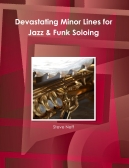Here’s another solo transcription I started working on a few weeks ago. This is from one of my favorite tenor sax players, Bob Mintzer. I love Bob’s playing because it is so melodic and thematic. He always plays ideas that you can grasp on to and that are catchy, yet he mixes in some pretty hip and advanced harmonic concepts into his lines. This solo is from Bob’s solo on “Invitation” from the CD Bopboy.
This is two chorus solo that starts at 1:12 of the tune. I am sill working on new solos each week and I will add them to the Neffmusic blog as I finish each solo. Thanks, Steve
A few things to think about while looking at and practicing this transcription:
- There are many dominant chords where I notice Mintzer using lines based off the melodic minor scale a half step up. Look at measures 22, 26 and 70. This is a common usage of the melodic minor scale and gives you lines that are also based off the altered scale. For example, on bar 22, F#7 Mintzer is basing his line off of G melodic minor. GABbCDEF#G. This is the same scale as F# altered F#GABbCDEF#.
- Notice how Bob uses a 3 against 4 simple rhythm to make things more interesting in measures 51-53
- Bob uses a lot of 9th’s and 13th’s in his lines and melodic statements. He isn’t always landing on the chord tones. Check out measures 15, 19-20, 25, 41-42, 62-63, 67-68 and 71-72.
- I notice Bob using the B altered scale whenever he gets to the F7(b5) chord. BCDEbFGAB. Of course this could also be a C melodic minor or he is just thinking an F mixolydian scale with a #11. Although, the way the lines are shaped and based around B makes me think B altered. Check out measures 29-30 and 77-78.
That’s about it for now, If you have any other thoughts about this solo please feel free to let me know in the comments below. Thanks again to Bob Mintzer for his great playing and all he does on a daily basis to promote jazz music and education. Now I have to pick another solo to start for next week………….
If you are interested in learning more about the altered scale and sound I have these video lessons on the subject in my Neffmusic Lesson Store:
- Altered Dominant Bebop Scale-Lesson 1
- Altered Dominant Bebop Scale-Lesson 2
- Altered Dominant Substitutions-Lesson 1
- Altered Dominant Substitutions-Lesson 2
- Altered Dominant Substitutions-Lesson 3
- Chord Substitution Lesson 2-The Tritone Lesson
- II-V-I Altered Scale Mastery-Lesson 1
- Minor Chord Substitution Lines Lesson
- Minor ii-7b5-V7b9 Substitution Lesson 1
- The Altered Scale Lesson (Beginner Lesson on the scale)
If you like the lines in this solo or love other tenor players like Michael Brecker or Bob Berg, check out my book “Devastating Minor Lines for Jazz and Funk Soloing”. It contains 100 killer modern 16th note lines in the styles of these players in all 12 keys………You can hear samples and read reviews by clicking on the link below. Thanks, Steve




Hi Steve, hope you are well. I play a Selmer mark six tenor. I’t still in almost new looking condition. I haven’t touched it since I was twenty one, now i’m a young sixty!..A lot of years not to be using my musical talent. I have a lot of chords to memorize. my favorite sounds are Dexter Gordon, Gene Ammons, Stan Getz, and Micheal Brecker.
I was playing on a meyer medium opening. I’m playing on a Phil-Tone equinox, the bore is very open for me and took me time to adjust to it. Only when I play every day and my horn is warmed up, can I get a full open sound that I am liking. I’m medium framed at 165 lbs standing bat 5′-11″. I find that it takes a lot of air and also I finally figured out the proper way to drop my jaw and use air the air pressure from watching Stan Getz. I feel that it shouldn’t be so hard to be getting a comfortable flow to get that rich sound that ,from what I understand is what every player wants to achieve. I have noticed that players using a brass gold plated mouthpiece like Micheal Brecker used have this more easy flowing nature to it.
My question for you is and I know Brecker had his metal mouthpiece designed for him and I know from a reed commercial using Brecker as the spokes person that he used a 2-1/2 strength reed with it, Would you know who designed his mouth piece? Also if you could have some comments for me it would be much appreciated. Thank you Patrick.
Hi Patrick,
Like Jason said, Brecker played a Guardala mouthpiece that Dave Guardala made for him. What you are experiencing when going from the Meyer to the Equinox is pretty normal. The Meyer has a smaller chamber so you don’t have to work as hard or use as much air as on a larger chambered piece. The more you play on the Equinox the more you will get used to it and you will get used to blowing the required amount of air. Steve
He played a Dave Guardala, but Brecker’s horn was also set up so that it was extremely free blowing. He had an issue with his neck where he could not put a lot of air through the horn so it was set up that way. That’s what I heard from repairman Ken Beason anyway. If there are any corrections to this please let me know, don’t want to post wrong information.